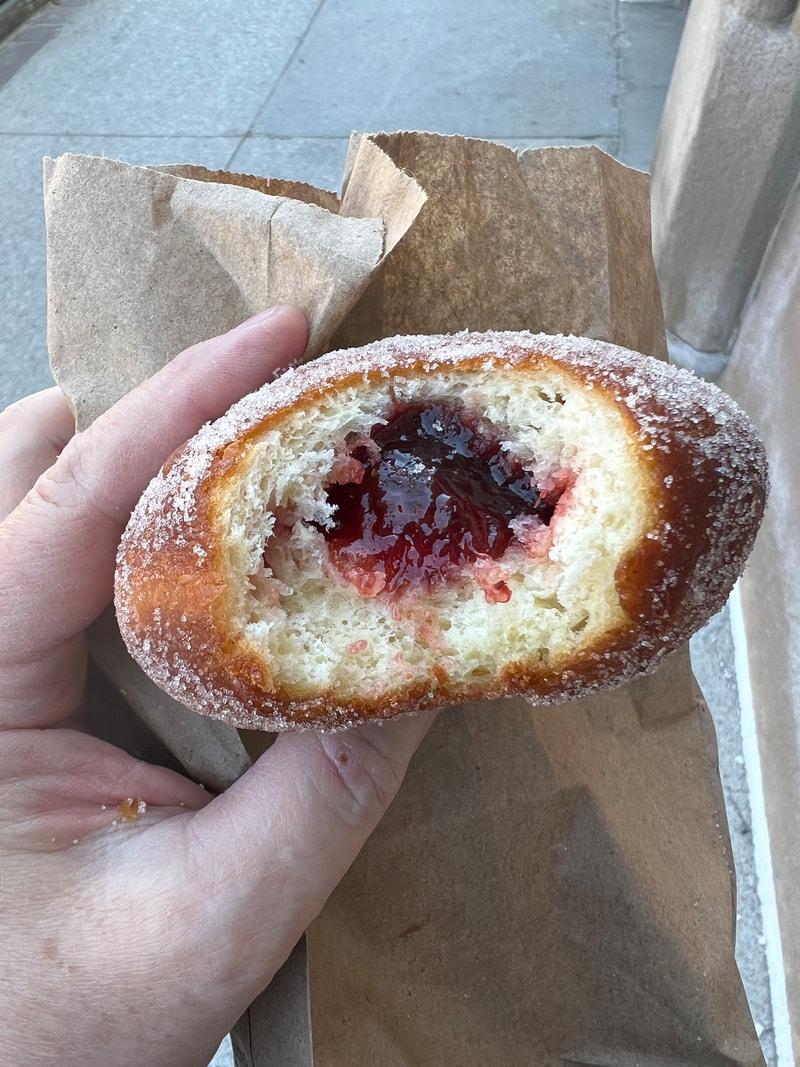|
Do you know what's trending in Toronto bakeries? Jam-filled doughnuts. I had this one on Friday afternoon. An "it's the weekend" treat. But when it comes to reasons to eat doughnuts, I can think of a million and one — including maintaining my menopausal midriff. I mean that in the most loving way. Trying hard to appreciate growing older. It's from Petite Thuet. I had to step out of the sidewalk crowd and stop to eat it. It demanded my attention. One of the big joys is the heavy sugar coating. It's messy. I felt like a kid. When it was done, I raised my arms toward the powder blue sky. A salutation. Momentarily transported to a happy place. Just me celebrating on Yonge Street. I'm a jam maker, and it's about the guts — this one was raspberry. The ratio of dough to jam was perfect. This is a critical detail. It's wholly unsatisfying when there's not enough filling. The dough was soft but not completely tender and white, which made me curious about the fat. Dough plus filling is simple. And real difficult to do right. Bà Nôi fills their doughnuts with stewed rhubarb and custard if you're looking for seasonally sublime. You definitely need it. Also, a butter tart chaser. I've been a few times. I like that bakery a lot. I'm glad I don't live closer. In Bloor West Village, the local Polish deli, Kingsway Meat Products, sells Paczki from a bakery we're still trying to sleuth (we're pretty sure it's in Etobicoke). The quince-rosewater filling and eggshell thin sugar glaze are an Eastern European dream. Go early. *** The men in these videos look like my friends from high school or someone I dated. I was a classic 70s teenage girl. I loved both songs. Still do. I grew up in a golden era. 19771974The first French book I bought for myself as an apprentice. On Valentine's Day. Made by Gault-Millau with an introduction by Pierre Salinger — an American journalist and politico who looks like Paul Bocuse's long-lost brother. (You need to look — classic 70s guy.) Here's an episode on Burgundy of the PBS show. At the time I was working in the kitchen with André Donnet in Hamilton at L'Escargot. A terrific cook and a good guy. My golden start. In the early days of yearning. I flipped out for French food — strutted right off the end of the high diving board at the local quarry. In almost 35 years, it has taken me to interesting places. I mean that wholistically — from extraordinary to terrible. Hard work made me fortunate. I paid my dues. I spent too much time with French men. I'd like to write some of those stories. My adorable book inscription is below. Like a schoolgirl, the pen drawing of the heart is a pre-emoji emoji. Beside it is a photo of the chef I worked for in France five years later. My fate was sealed at the Table of Contents. On February 14, 1988. How completely happenstance. Life's poetry. It took five years to turn that dream into reality. I had enough confidence in André to tell him early. He never led me to believe it was impossible. That's one reason why it happened. I hope you all know the pleasure of realizing a long-term goal. I remember the people who got me there and those who were barriers. Because that's life. I bought the book at Edwards. Remember that Queen Street West? Those were the days. I am old. Now it's like the Mall of America (with a few exceptions). If you feel up to it, show me the first cookbook that meant something to you as a young cook. Send a photo or link to me on social media. *** I lost a friend two weeks ago. A woman who was there for me in my early recovery. We were close for almost 20 years, and then we drifted apart. What a cook — I would sprint to her dinner table. A blue-ribbon amateur. We spent lots of time in the kitchen together. I can hear her belly laugh sitting here writing this. She had the joy of living in the human sense. She was a long-time meditator. We would sit in morning meditation up at her cottage — in chairs facing one another. The gentle lap of water on the lakeshore, the busy morning trill of birds making the day's plans, maybe the lone wail of a loon if it was overcast. There's nothing like a friend you can be quiet with. Also, friends, you can read around. And older friends. I talked to her husband of 59 years this past week. It was a nice conversation. We laughed, and it was solemn. I remember her in many ways — smiling in the sauna and jumping in an icy lake, both of us on the VIP tour of Graceland. Times you never want to end. Completely grateful. *** I picked the songs for my heart. Elton John and Bernie Taupin were extraordinary storytellers. They could write for his uniquely baritone voice and the piano. Top of the Pops was a big deal. Both performances about a year apart when things were taking off for him in Britain. They are subdued, but his brilliance as a showman in the jackets and the lighting in the second video is clear. A man behind a piano. A legendary performer. Close your eyes and imagine being in Royal Festival Hall in 1972. 19711972If I ever have a garden again, the first thing I'll plant is black currant shrubs. A glut of the berries in July is a blue-ribbon problem. I'd gather them in greying popular fruit baskets to make the Cassis Jelly recipe on page 231 of Saving the Season. According to a note on the page, I made it first on July 24, 2013 — a Wednesday. My muslin jelly bag is permanently stained an inky black purple like the colour of a new tattoo. The flavour of berries, citrus, and herbs is a palate stunner. It's got pucker. Spreading it thick on toasted sourdough with melting cultured butter is a pleasure. Eating it standing barefoot in dewy grass is even better. Cassis jelly is a country good morning. "Recipes need stories," writes Kevin West. Now you know why I like the book. It's made by a writer in no big hurry. To say it's about preserving is not the half of it. Like a Tennessee Waltz quilt, West stitches together recipes for Sunshine Pickles and Peach Jam with essays on a Shenandoah Valley road trip and the sensual vegetable portraits of Charles Jones. There are lines of poetry from Pablo Neruda, "I want to do with you what spring does with the cherry trees." On almost every page, there's a new seduction. "Lemon verbena and sweet wine in the first variation provide weightless layers of flavor, akin to the translucent atmospherics in a Turner painting," he writes about Apricot Jam with Honey and Lemon Verbena. Threading a homely craft to a master painter is the work of a writer who embraces culture with warmth and generosity. The headnotes are like cocktails before dinner, with nice snacks. A space to build appetite and nurture a connection with the reader-cook. West delivers technique with a side of charm. In the intro for Zucchini Dill Spears, he recalls something his mom said about growing zucchini that will bring a smile to a gardener's face. "After you pick a plant clean and walk away, you can glance back over your shoulder and see new ones that already need picking." Any opportunity to tie the kitchen to the garden is seized. "We are saving, even in our urban kitchens, a sense of the agricultural cycle," he writes in an essay on Edna Lewis. There's a photo of seven-year-old West holding a flat of sun-warm crimson strawberries on page 52. Smiling for his mom behind the camera. The two of them just back from picking. He's a wholesome vision of childhood in worn jean coveralls and no shirt. I go to the book mostly for jam, jelly, and marmalade. My passion. Because it's made without commercial pectin. I like the challenge. The cook must consider the season's imprint on the fruit's fragrance and taste. Or, as West says plainly, "Getting it right each time is different." Maybe it's owing to his Southern roots, but West excels at making introductions. We meet June Taylor, a jam-maker he calls an "archeologist of pre-industrial country life." To get a sense of her obsession, Taylor labels her preserves according to fruit varietal. And another California jam-maker, Robert Lambert, says, "I don't want to run a business…I want to make stuff." (If there was ever a mantra for my working life, that's it.) If you need to ask how much their jam costs, you don't know a stick about what goes into making it this way. But for the record, it's a lot and not near enough. West and his friends "put up" in small batches. This is not your family's all-day-by-the-bushel-canning-bonanza. Those days are mostly past. But the photo of Ada Mae Houston's root cellar on page 421 will stir nostalgia for that home-grown abundance. The cookbook's been open on my kitchen table while Mason jars made a racket in a boiling water bath, and a trail of sweat ran down the small of my back. And I've sat and read it for the learning. There's joy in it, and not just for the cook. We're friends if it's in your collection. There are homespun innovations. West suggests lining the bottom of a water bath with ring lids instead of a rack to raise the jars off the direct heat. And he fills a Ziploc bag with brine to use as a weight for a crock of dill pickles in case it springs a leak. West would be eyeing the ring-bound books in your grandmother's kitchen for inspiration. Mrs. Dorsey Brown's Green Tomato Pickle is a church-lady recipe from a St. Thomas parish cookbook near Baltimore. And the Orgeat, or sweet almond milk, has roots in a 19th-century cookbook, The Kentucky Housewife by Lettice Bryan. Last week I added more 'to-make' tabs for Cherry Preserves with Red Currants and Piquant Pears with Bay Leaf and Black Pepper. The book is crafted with Stahl house care. Modern Americana with its heart in California. I could take it from the preserving section and squeeze it between Zuni and Chez Panisse Cooking on the shelf. Where it sits in my heart. West wrote the book in the Hollywood Hills in a place called Greenvalley. Take me there. West writes about a friend's cookbooks: "What distinguishes Ziedrich's two Joys are the intangible qualities of ambition and authority, traits common to all enduring cookbooks." An apt counter-narrative for much in our high-speed machine-made world. Clear through to the end, he delivers. The Epilogue is a solid reference section. My three-word blurb: — endearing and enduring. Saving the Season is a book to pass through generations. *** The brilliant pop-art strawberry is from Jay Heins at Numen Communications. He's art directing on the cookbook posts. What a relief to focus on the words. And to collaborate with a talented, creative human. Less is more for me these days. I'll be posting every two or three weeks about a cookbook. *** I went back and forth on the music. Settled on the new and the old. I could serve Steve Winwood in so many ways — the Spencer Davis Group, Traffic — but I chose Blind Faith. An extraordinary musician right from the start. © strawberry by eva.yuna via Freepik. 20231969 |
Archives
July 2024
© Deborah Reid, 2021 - 2024. All Rights Reserved. Categories |








 RSS Feed
RSS Feed